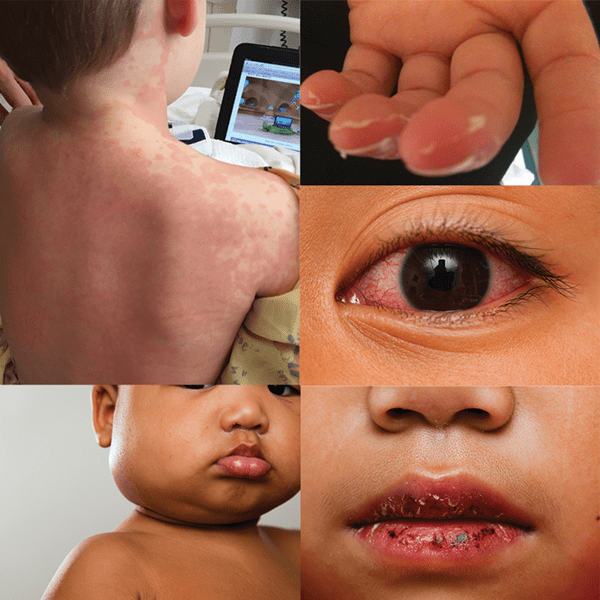Kawasaki Disease
Quick Facts
- Kawasaki disease (KD) can cause heart disease in children and teens.
- Fast treatment is needed to prevent serious heart problems.
- Symptoms include a persistent fever, bloodshot eyes, swelling and irritated skin.
What is Kawasaki disease?
Kawasaki disease (KD) is the leading cause of acquired heart disease in children in developed countries. It was once called Kawasaki syndrome or mucocutaneous lymph node syndrome.
KD affects children and teens. It causes swelling (inflammation) in the blood vessels, especially in the coronary arteries. The average age of those affected is 2 years. About 77% are younger than 5. Boys are 1.5 times more likely than girls to get KD.
The illness occurs worldwide and across all racial or ethnic groups. It’s more frequent in Japan and in children of Asian descent. The condition was named after Dr. Tomisaku Kawasaki, a Japanese pediatrician. It was first described in 1967. It may have been around for a long time before then.
Prompt treatment is critical to prevent serious heart problems. Most children recover fully.
What are the symptoms of Kawasaki disease?
KD is diagnosed when a patient runs a fever for at least five days. The fever typically lasts 7 to 12 days and stays above 101.3 degrees Fahrenheit (38.5 degrees Celsius) for most of the illness. At least four of these five symptoms are also present with the fever:
- Bloodshot eyes (conjunctivitis) that are often sensitive to light
- Swollen lymph nodes in the neck, usually on one side and measuring more than 1.5 centimeters (0.59 inches)
- A rash that often starts in the genital area and can also be on the chest, back, belly, arms and legs
-
Red and swollen palms and soles of the feet when the illness starts.
- Peeling skin on the fingertips and toes in the second and third weeks
- Larger pieces of skin peeling from the hands and feet
-
Irritated and swollen mouth, lips and throat, including:
- “Strawberry” tongue — red tongue with enlarged bumps
- Red, swollen lips that may crack
Some children have incomplete KD, where not all the classic symptoms appear. Doctors may suspect this in children who have a fever lasting more than five days along with some, but not all, of the other signs.
Other symptoms that may be present:
- Joint pain or swelling (temporary arthritis in about 1 in 4 children)
- Belly pain
- Vomiting or diarrhea

Photos courtesy of Kawasaki Disease Foundation
What causes Kawasaki disease, and how can it be prevented?
We don’t know what causes KD. Some suspected causes include:
- Genetics
- Infectious causes, such as viruses
- Environmental factors
- Immune response
There is no evidence that KD is spread from person to person. It’s not hereditary. Rarely, more than one child in a family develops it.
Because the exact cause of Kawasaki disease is unknown, there is currently no proven way to prevent it.
How is Kawasaki disease diagnosed?
There is no single test for KD. A health care professional will examine your child, review symptoms and rule out other conditions. Blood and urine tests may show signs of inflammation but are not specific to KD. If KD is suspected, an echocardiogram (heart ultrasound) is usually done to check for heart involvement, especially to look at coronary arteries. Other imaging or blood tests may also be recommended.
An echocardiography will give a clear picture of the coronary arteries and how the heart is working. This may help in making a diagnosis. The health care professional may also ask for other tests.
How is Kawasaki disease treated?
All patients with KD should be admitted to the hospital to get IVIG (intravenous immunoglobulin) and aspirin and for observation until fevers have resolved.
When given early in the illness, IVIG can reduce the risk of coronary artery problems.
Aspirin can help fever, joint swelling and pain. It can also help stop blood clots from forming. Aspirin is usually not given to children because of the risk of a rare condition called Reye’s syndrome. However, in Kawasaki disease, aspirin is a critical part of treatment and considered safe when used under medical supervision.
How can it affect heart health?
Without fast treatment, KD can damage the coronary arteries in about 1 in 4 children. This can lead to:
- Coronary artery aneurysms (bulges in the artery wall)
- Myocarditis (inflammation of the heart muscle)
- Heart valve swelling
- Irregular heart rhythms
While some of these issues improve over time, damage to the coronary arteries can be permanent and may need lifelong monitoring and follow-up care.
Will my child have long-term issues?
Most children who are treated early recover fully and do not have long-term problems, especially if they did not develop coronary artery aneurysms. However, it may take one to two months to return to normal activities. Rest and gradual recovery are important during this time.
Children with coronary artery aneurysms need ongoing care with a pediatric heart doctor. As they become adults, their care should be moved to an adult heart doctor experienced with KD. Most importantly, people with moderate to large persistent aneurysms need lifelong cardiology follow-up. This includes:
- Yearly or twice-yearly cardiology visits
- Imaging and heart function tests
- Monitoring for complications such as narrowing of the arteries or blood clots
Learn more:
- View our patient fact sheet: What is Kawasaki Disease? (PDF)
Support that lifts you up

Our online community of patients, survivors and caregivers is here to keep you going no matter the obstacles. We’ve been there, and we won’t let you do it alone.






